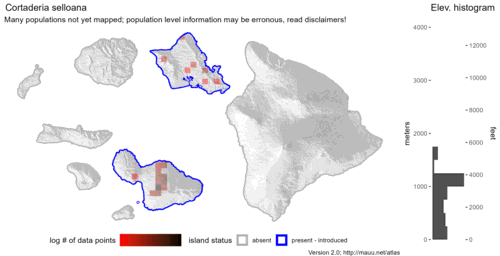Info
Subfamily: Danthonioideae
Genus etymology: Cortaderia = "a knife used for cutting honeycomb" [Spanish] refering to the sharp edges of the leaves
Species etymology: selloana = honorific for Friedrich Sellow (1789–1831)
Photosynthetic type: C3 (cool season)
Nativity: naturalized - intentional
First recorded in Hawaiʻi: 1909
Map


Plant

Description
Plants usually dioecious, sometimes monoecious. Culms 2-4 m, usually 2-4 times as long as the panicles. Leaves primarily basal; sheaths mostly glabrous, with a dense tuft of hairs at the collars; ligules 1-2 mm; blades to 2 m long, 3-8 cm wide, mostly flat, cauline, ascending, arching, bluish-green, abaxial surfaces glabrous basally. Panicles 30-130 cm, only slightly, if at all, elevated above the foliage, whitish or pinkish when young. Spikelets 15-17 mm; calluses to 1 mm, with hairs to 2 mm; lemmas long-attenuate to an awn, awns 2.5-5 mm; paleas to 4 mm; stigmas exerted. Caryopses and florets not separating easily from the rachilla. 2n = 72.
(Description source: Barkworth, M.E., Capels, K.M., Long, S. & Piep, M.B. (eds.) 2003. Flora of North America, north of Mexico. Volume 25. Magnoliophyta: Commelinidae (in part): Poaceae, Part 2. Oxford University Press, New York. 783 pp. http://floranorthamerica.org/Cortaderia_selloana )